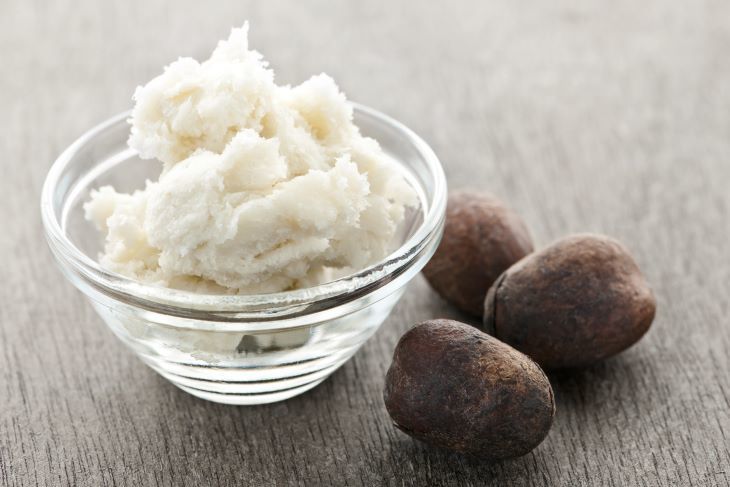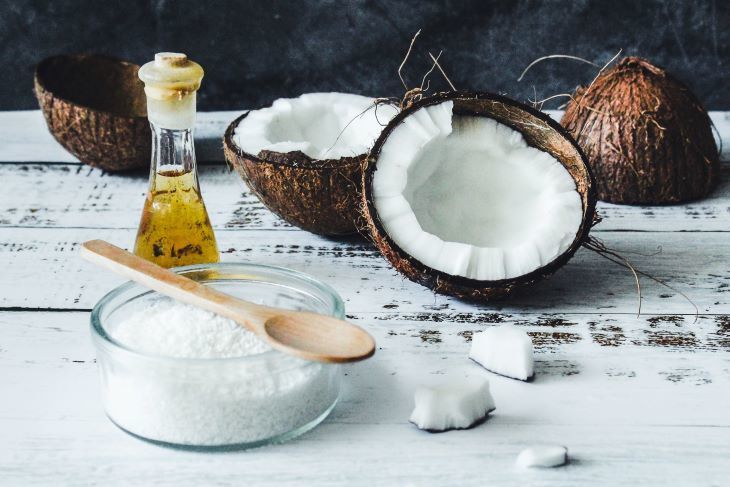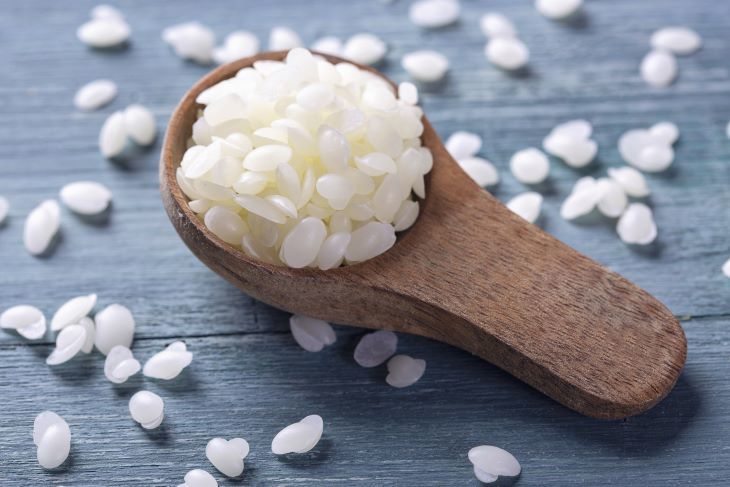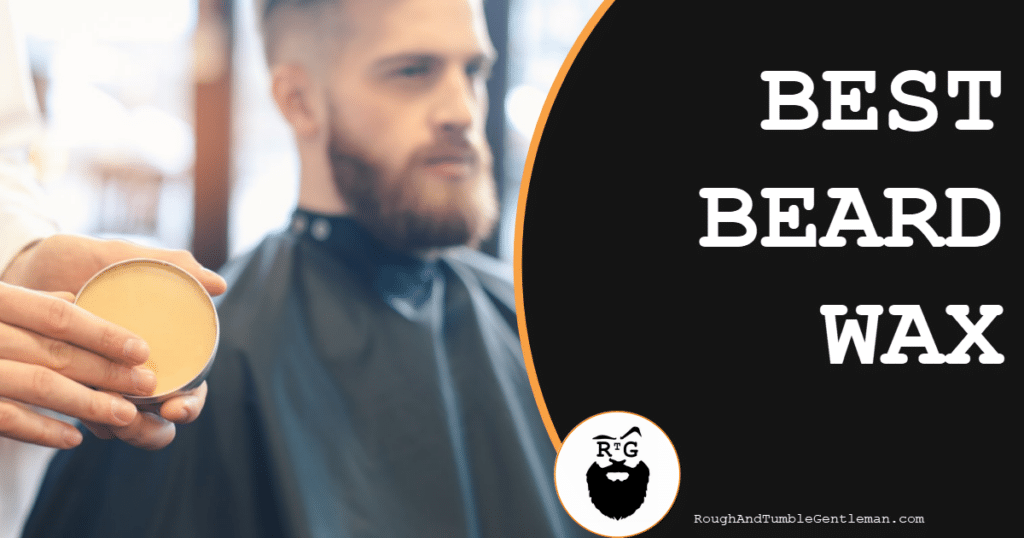Beards have a mind of their own, and without some serious intervention, they can travel every-which-way while you’re out and about. Beard oils and beard balms can help, but when it comes to really keeping a beard in line, nothing can replace a beard wax—and nothing tames better than a beard wax you yourself have created.
So to help you tame your wild-at-heart beard, we’ve designed three DIY beard wax recipes to get you started. Creating homemade beard wax is not only surprisingly easy, it’s incredibly useful—if you’re a lover of the ultra-groomed and neat beard look, beard wax is a must, and these three beard wax recipes won’t disappoint.

Keep in mind, you don’t have to follow our recipes exactly—if you’d like to make your homemade beard wax truly unique, be sure to read our entire article all the way to the end.
After we share our three favorite recipes, we explain how you can customize your beard wax. Happy formulating!
3 Beard Wax Recipes for Every Beard
We kept the first recipe ultra-simple, opted for a vegan formula for our second recipe, and then designed a slightly more complex but ultra-moisturizing beard wax for those who want a little more oomph. First up:
Basic Beeswax Recipe
This simple recipe is the ideal starting point. The ingredients in it are pretty basic, and you can find them easily in stores.
We designed this formula with beeswax, which is important for giving your beard that firm hold, shea butter for added creaminess, and coconut oil which has beard nourishing and conditioning benefits.
Once you’ve given this recipe a try, you’ll get a good sense of what you like, and you’ll be able to adapt and change things based on your preferences.
Ingredients:
- 1 oz beeswax pellets
- 0.75 oz shea butter
- 0.75 oz coconut oil
- 5-10 drops of essential oil
Instructions:
Step 1: Turn Up the Heat. Since all of the ingredients for this beard wax are solid at room temperature, the only way to combine them is by melting them together. Use a water bath or double boiler setup to gently heat up the beeswax, shea butter, and coconut oil. This way, they’ll melt slowly and gently without ever reaching a boiling point.
Step 2: Mix Things Up. Once your main ingredients have melted, mix them with a spoon or spatula. Then, remove the blend from the heat.
Step 3: Add the Essential oil. Once your mixture has cooled down a little, add the essential oil. If you don’t let it cool, most of your essential oil will evaporate immediately from the heat, which is a terrible waste. After adding the essential oil, give the blend another mix.
Step 4: Decant and Cool. Now you need to act quickly! Before your blend has time to solidify at room temperature, move it into a sealable tin or jar. Place it somewhere safe where it can finish solidifying, or put it in the fridge if you’re itching to give it a try. Once it sets completely, you’ll be able to use it right away.

Vegan Beard Wax Without Beeswax
If you’re a vegan or you’re allergic to honey, you may want to avoid beeswax in your DIY beard wax concoction. Thankfully, plant-based waxes like candelilla wax can work as an alternative.
However, candelilla wax isn’t totally identical to beeswax. It’s a little bit shinier and it’s also denser and harder. To achieve the same level of hold as we would with beeswax, we had to use candelilla at a lower percentage of the overall recipe. Instead, we increased the amount of shea butter, although you can choose to increase the amount of oil, instead.
Ingredients:
- 1 oz candelilla wax pellets
- 1.5 oz shea butter
- 1 oz coconut oil
- 5-10 drops of essential oil
Instructions:
Step 1: Melt Your Base. As with our previous recipe, the first step is to melt your base ingredients together. That means the wax, the shea butter, and the coconut oil. Use very low heat (we highly recommend a double boiler) so that the ingredients melt gently without the heat changing their basic structure.
Step 2: Mix and Remove from Heat. As your ingredients start to melt, make sure to stir them so that they can combine properly. Once they’ve melted completely, remove the mixture from the heat and let it cool down a little.
Step 3: Fragrance Time. Once the mixture isn’t too hot, add your essential oil of choice and give the blend a good stir.
Step 4: Store and Cool. Finally, pour your mixture into its final home—a glass jar or a metal tin should work well. Store it somewhere safe so it can cool down completely. Once it achieves a solid texture, you can start using it.

Extra-Moisturizing Homemade Beard Wax
The main purpose of beard wax is to help you style your beard, rather than condition or moisturize it. However, that doesn’t mean you can’t enjoy any moisturizing benefits!
All of our recipes are somewhat conditioning, but this one takes it up a level with a blend of 5 extra-nourishing and protecting oils and butters.
Ingredients
- 1.5 oz beeswax pellets
- 0.5 oz shea butter
- 0.5 oz cocoa butter
- 0.25 oz coconut oil
- 0.25 oz argan oil
- 0.25 oz jojoba oil
- 5-10 drops of essential oil
Instructions:
Step 1: Melt Gently. To get all of these nourishing ingredients to combine, you’ll need to melt them over very low heat. Combine the oils, butters, and wax, but leave out the essential oil. We always recommend using a double boiler, since it’s the gentlest way to melt down waxes and butters without overheating them.
Step 2: Mix and Cool. As your solid ingredients start to melt, stir your blend to get everything to mix. Once your mixture has achieved a cohesive, fluid texture, take it off the heat and allow it to cool slightly.
Step 3: Fragrance It Up. Now, add the essential oil to your mixture, and stir it one more time to combine.
Step 4: Let It Set. Finally, it’s time to let your blend set so it can become a solid beard balm. While it’s still fluid, pour the mix into the final container, which should be a sealable tin or jar. Then, place it somewhere cool and safe where it can set into a firm, waxy texture.

Customizing Your DIY Beard Wax
We kept our beard wax recipes pretty simple, but what you end up making can be anything but. There are a lot of different ways to change things up, so here are some ideas to help you customize your homemade beard wax.
Change Up the Wax
Wax is the most important ingredient in beard wax. After all, it’s what’s responsible for the beard wax’s ability to smooth down errant beard hairs and keep them in place.
- Beeswax is the obvious choice in a beard wax recipe. It’s natural, easy to find in stores, and it offers a firm touch with fantastic hold thanks to its slightly sticky nature.
- Candelilla wax is our go-to vegan replacement for beeswax. It’s fairly accessible, and it offers a decent level of hold. It’s much harder than beeswax, which is why we use a smaller quantity of it. It also has a bit of a sheen and a touch less stickiness, which is worth keeping in mind. If you like the idea of giving your beard a slight sheen but you don’t want to compromise hold, you can substitute half the amount of beeswax you planned to use with a quarter amount of candelilla.
- Carnauba wax is even denser and slower to melt than candelilla wax. If it’s all you have available, you can still achieve a nice, slightly glossy beard wax, although its hold won’t be as good as with beeswax. Once again, it’s not a one-to-one substitution with beeswax. Instead, you should use about 1/2 or even 1/3 the amount of beeswax your original recipe calls for.
- Soy wax can be a little pricey, but it’s a worthy vegan substitute for beeswax. Unlike candelilla and carnauba, it’s actually quite soft, so you’d actually need to increase the amount of wax in your recipe to achieve similar results to beeswax. It offers good hold, and it’s all-natural. You can blend it with candelilla, as well, for a very firm vegan formula that gives great hold.
Play With Fragrance
The fragrance you choose for your DIY beard wax is extremely important. The scent of your beard wax won’t be quite as strong as that of a cologne, but you and anyone else who gets close will probably still be able to smell it.
Adding a scent to your beard wax is also pretty important if you’ve used shea butter. Shea has an earthy, nutty smell that can be very polarizing, so many beard-havers use essential oils to mask it.
If you’re not familiar, essential oils are volatile liquids that hold most of the fragrance compounds from a given plant. They’re strong and concentrated, so it only takes a few drops to fragrance your creation.
When choosing the essential oils for your beard wax, consider the other products you use. Make sure to choose an essential oil that won’t clash with the smell of your aftershave, cologne, or any other scented products.
So, which essential oil should you use? Here are some of our favorite individual scents:
- Cedarwood is woodsy and masculine, so it helps to enhance a lumberjack vibe.
- Sandalwood is another great woodsy smell with a bit more warmth.
- Peppermint is a cooling, classic scent for any beard product. A beard wax shouldn’t touch your skin, so you won’t feel its cooling touch, but you’ll definitely smell it.
- Lemongrass is extracted from an herb, but as the name suggests, it’s also reminiscent of lemon. It has a slightly spicy undercurrent that makes it more unique and interesting.
- Bergamot is another citrusy essential oil. It has a complex scent that’s reminiscent of both orange and lime, so it’s uplifting yet unisex.
- Clary sage is an herbal essential oil with both sweet and musky notes.
- To make your homemade beard balm even more sophisticated, consider creating a signature fragrance blend. Here are some combinations we like:
- Winter Woods: Cedarwood, peppermint, pine, and tea tree essential oils.
- Sharp Citrus: Orange, bergamot, lemongrass, and cedarwood essential oils.
- Feeling Spicy: Lavender, clove, black pepper, and frankincense essential oils.
- Smoky-Sweet: Tobacco, vanilla, tonka bean, and bergamot essential oils.
- Pirate Life: Rum, vanilla, cedarwood, and lime essential oils.
Try Different Oils and Butters
Beard waxes would be entirely solid and impossible to use if it wasn’t for carrier oils and plant butters. Both are very important ingredients in a beard balm, and within each category, there are many varieties to try.
To start, plant butters are the more solid of the two. They’re creamy and, when warned up, they melt into an oil. They work well to sheer out and soften beard wax without compromising its firmness.
Shea butter is the most commonly used plant butter in beard waxes. It has a pleasant texture, it works for all skin types, and it doesn’t cause breakouts. It also has robust moisture-sealing capabilities, so it’s useful for moisturizing both beard and skin. It has a nutty, earthy smell that many people dislike, which is why essential oils are a must.
Mango butter is a great butter to try if you want a slightly more dry-feeling and matte beard wax. It’s absolutely loaded in antioxidants and it’s nearly as moisturizing as shea butter. Give it a try if you want to branch out.
Cocoa butter is really wonderful in beard waxes, especially if you’re a fan of all things chocolate. It’s rich and moisturizing, so it’s a nice choice for dry beard hair. It’s worth mentioning that it is slightly likely to cause acne, but since beard waxes don’t really come in contact with the skin, it shouldn’t be an issue.
Carrier oils are also moisturizing, like plant butters, but they’re more fluid at room temperature. They work well to lighten and soften a beard wax, so if you find your recipe is a little too dense, feel free to increase the amount of carrier oil in it.
Coconut oil is our favorite carrier oil for beard waxes because it’s a little creamier and more solid than the average carrier oil (although it’s still softer than butter). While the wax and plant butter coat the beard hairs, coconut oil actually penetrates into them, helping to soften and fortify the beard from within.
Jojoba oil is technically a wax ester, but it’s still great for the beard. It’s a coating oil, so it’s a good choice if your beard is strong but sometimes gets a little frizzy or dry. It also offers a slight sheen, if that’s the kind of look you’re going for.
Argan oil has become very popular in recent years. It partially coats and partially penetrates the hair shaft, so it’s a nice in-between to jojoba and coconut oils. It also contains a lot of antioxidants that may fortify your beard from external damage throughout the day.
Grape seed oil is a great oil to choose if you want a beard wax that feels a little less greasy or shiny but still gives the beard smoothing and moisturizing effects. It’s one of the lightest, least-oily plant oils, and as a bonus, it’s quite affordable. Just keep in mind that it has a very short shelf-life compared to other oils.
Olive oil can be found in every pantry. It’s a great moisturizing oil for the beard, but it’s not our favorite in beard wax. It has a slightly stronger smell than many other oils on this list, so you may find yourself having to compensate with extra essential oil to camouflage it. If it’s what you have on hand, however, feel free to use it.
Beard Wax Storage and Shelf-Life
Beard wax is a wonderful choice for your first DIY because it’s very easy to store and it takes ages to go bad. Beard wax is considered anhydrous, meaning that it’s water-free and therefore unlikely to grow harmful pathogens.
Our basic beard wax recipe could easily last you for over a year!
To ensure that your beard wax stays fresh for as long as possible, store it in a sealable metal tin or glass jar, and keep it away from heat or moisture.
If you use any oils with a shorter shelf-life, you can also add a bit of vitamin E to help stabilize them and to prevent your beard wax from going rancid prematurely.
Tame Your Beard Your Way
Making a beard wax recipe is pretty easy, even if you’ve never made your own beard care products before. Every time you use your homemade beard wax to tame your beard, you’ll feel the immense pride of being so self-sufficient.
Your friends will be impressed when they find out what you use to keep your beard neatly groomed and smelling great—you can even double your batch, to give them a beard wax of their own.
So which recipe will you make? Leave us a comment or reach out to us via our contact page to let us know.
Michael Morris is the head writer here at Rough and Tumble Gentleman. He's got a ducktail beard and loves Brazilian jiu-jitsu. He's married to the woman of his dreams and lives in Brooklyn, NY.



